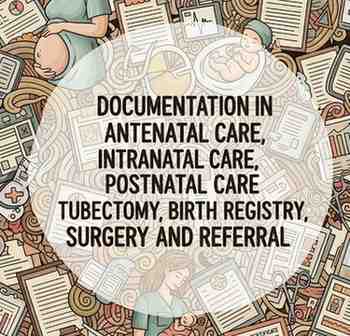
Your Account
Designed by Zeptt Technologies

Practice documentation is a systematic record of medical care, procedures, outcomes, and referrals maintained by the healthcare provider.
In Ayurveda, systematic recording ensures continuity of care and reflects on Yuktivyapashraya Chikitsa.
It helps in legal, academic, research, and administrative purposes.
In obstetrics and gynecology, detailed documentation during the phases of pregnancy and delivery is crucial for maternal and neonatal safety.
ANTENATAL CARE DOCUMENTATION
Definition: Antenatal care is the care of the pregnant woman before the onset of labor.
Key Documentation Points:
Complete personal and obstetric history (Gravida, Para, Abortions, Living).
LMP (Last Menstrual Period) and EDD (Expected Date of Delivery).
Regular check-up entries including:
Blood Pressure
Weight
Fundal Height
Fetal Heart Sound (FHS)
Urine examination
Hemoglobin level
Ultrasound findings
Iron and folic acid supplementation.
Tetanus toxoid injections.
Dietary and lifestyle advice (Pathya-Apathya).
Any complications (like PIH, GDM, Anemia).
Advices on Garbhini Paricharya as per Ayurveda.
Sanskrit Reference:
गर्भिण्या आहार विहारं च विशेषेण समाचरेत् ।
गार्भिण्याश्च महीस्नेहः सदा कार्यो विशेषतः ॥
(Aṣṭāṅgahṛdaya, Uttarasthana 2/8)
Modern Guidelines: WHO recommends at least 8 antenatal visits for proper monitoring and timely interventions.
INTRANATAL CARE DOCUMENTATION
Definition: Care provided during the process of labor and delivery.
Key Documentation Points:
Admission details including onset and duration of labor pains.
Partograph maintenance (modern tool to monitor labor).
Cervical dilatation and effacement status.
Presentation and position of fetus.
Rupture of membranes – time, color, and odor of amniotic fluid.
Mode of delivery (Normal vaginal, Instrumental, Cesarean).
Any intervention or complication (e.g., PPH, cord prolapse).
Medications and fluids administered.
APGAR Score of newborn and time of birth.
Sanskrit Reference:
प्रसवकाले विशेषेण योषिद्भिः स्यात् प्रसन्नधीः ।
शान्तात्मा धर्मनिरतः कर्तव्यो बन्धुभिः सह ॥
(Suśrutasaṁhitā, Śārīrasthāna 10/23)
Modern Additions: Use of sterile delivery kits, CTG monitoring, and immediate neonatal care per NRP protocols.
POSTNATAL CARE DOCUMENTATION
Definition: Care provided to the mother and the newborn after delivery for about 6 weeks.
Key Documentation Points:
General health check-up of mother (bleeding, uterine involution, breast condition).
Lochia observation.
Monitoring for signs of postpartum hemorrhage or infection.
Counseling on breastfeeding, contraception, and nutrition.
Neonatal care – weight, feeding, urination, vaccination schedule.
Mother’s emotional health screening.
Sanskrit Reference:
सूतिका सुतमुत्पाद्य सप्ताहं क्षीणमूत्रिणी ।
शयीत सन्ततं तस्मात् काषायं दीपनं पिबेत् ॥
(Aṣṭāṅgahṛdaya, Uttarasthana 2/40)
Modern Guidelines: WHO recommends postnatal visits at 24 hours, 48-72 hours, 7-14 days, and 6 weeks.
TUBECTOMY DOCUMENTATION
Definition: A permanent method of female sterilization by surgical ligation of fallopian tubes.
Key Documentation Points:
Consent form signed after explaining procedure and risks.
Preoperative assessment and investigations.
Surgical notes:
Type (Mini-lap, Laparoscopic).
Side and technique used (Pomeroy, Irving).
Post-operative care and vitals monitoring.
Discharge summary including follow-up advice.
Ayurvedic Correlation: Though not directly mentioned in Samhitas, sterilization falls under Apatkalika Karma (Emergency measures).
Modern Insight: Part of National Family Welfare Programme in India, especially postpartum sterilization.
BIRTH REGISTRY DOCUMENTATION
Definition: Legal and medical record of childbirth including details of both mother and newborn.
Key Documentation Points:
Name of mother and father.
Date and time of delivery.
Sex of the baby.
Mode and place of delivery.
Name of attending obstetrician.
Weight and condition of baby at birth.
Entry in birth registry and issuance of birth certificate.
Importance: Vital statistics, public health planning, proof of identity.
Modern Law: Registration of Births and Deaths Act, 1969 mandates registration within 21 days.
SURGERY DOCUMENTATION
Definition: Documentation related to operative procedures in obstetric and gynecologic practice.
Key Documentation Points:
Indication for surgery.
Consent form and risk explanation.
Pre-operative investigations and anesthetic evaluation.
Operative notes:
Procedure done.
Instruments used.
Duration and complications.
Post-operative instructions and medications.
Histopathology if applicable.
Follow-up schedule.
Common Gynaecological Surgeries: D&C, Myomectomy, Hysterectomy, Cystectomy.
Sanskrit Context:
यत्र यत्र यथाकालं यथा युक्तं यथाबलम् ।
कर्तव्यमेषां कर्मणां तत्र तत्र विशेषतः ॥
(Suśrutasaṁhitā, Sūtrasthāna 1/23)
REFERRAL DOCUMENTATION
Definition: Formal transfer of a patient from one level of care to another for specialized management.
Key Documentation Points:
Reason for referral.
Summary of findings and treatment given.
Accompanied documents (lab reports, imaging).
Urgency and type of transport arranged.
Contact details of referred center.
Importance: Ensures continuity of care and prompt management.
Modern Additions: Use of referral slips, telemedicine documentation, digital records in HMIS.